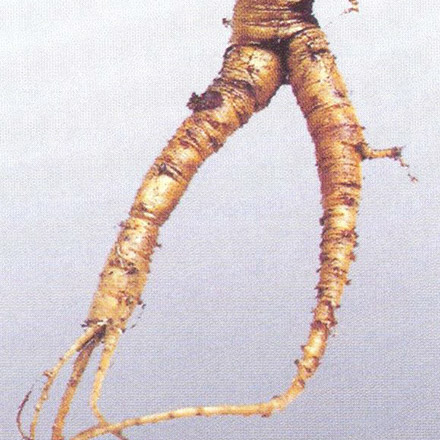Botanical name
Panax ginseng C.A. Mey. (Korean ginseng)
Panax notoginseng (Burkill) F.H. Chen (South China ginseng)
Panax quinquefolius L [Syn.: Panax americanus (Raf.) Raf.] (American ginseng)
Eleutherococcus senticosus (Rupr. & Maxim.) Maxim. (Siberian ginseng)
Family
Araliaceae
Common name
Asian ginseng, Black ginseng, Chinese ginseng, Japanese ginseng, Korean ginseng, Manchurian ginseng, Oriental ginseng, Red ginseng, True ginseng, White ginseng
Information about the plant
"Ginseng" is the Germanized spelling of the Chinese name for Korean ginseng: 'schen-schen' or 'schin-schen'. The name "ginseng" has also become common for other plants whose roots have an invigorating property, such as Chinese ginseng and American ginseng. The invigorating property is also found in the generic name Panax, which can be translated as "all-healing", derived from the Greek 'pan' (= all) and 'akos' (= remedy, healing).
Chinese ginseng is similar to Korean ginseng; therefore, it has carried for a long time the species epithet pseudoginseng var. notoginseng, derived from the Greek 'pseudo' (= to deceive), here in the sense of "to feign" (= feigns ginseng); the name used today is P.notoginseng.
The genus Eleutherococcus is also known in the literature under the synonym Acanthopanax, so to speak as "Panax with thorns" (from the Greek 'acantha' = thorn). In German, E.senticosus is also known as "Ginseng" - Siberian ginseng - because of its root, which also gives strength; the thorns attached to it are preserved in the species epithet senticosus, which means "rich in thorns", derived from the Latin 'sentis' (= thorn), with the suffix '-osus' (= rich in).
Korean ginseng (P.ginseng) grows in the shady mountain forests of East Asia from Nepal to Korea and Manchuria. Chinese ginseng (P.notoginseng) is native to the mountainous northeastern provinces of China. American ginseng (P.quinquefolius) grows in the shady, damp forests of northern and central North America and parts of Canada. Siberian ginseng (E.senticosus) is native to eastern Siberia, including the areas around Khabarovsk, Primorsk and the central Amur region.
Korean ginseng is a 30 to 80 cm high plant with a round stem, on which there are usually four long-stemmed, 5-fingered leaves in a terminal whorl. There are 15 to 30 small white-greenish flowers in umbels. The ovaries produce spherical, scarlet-red, shiny berries about the size of a pea, each containing two seeds. The spindle-shaped root with a split tip, which resembles the shape of a human being, is particularly characteristic. The other Panax species are similar in their habitus to Korean ginseng, while Siberian ginseng (E.senticosus) is a 2 to 3 m high shrub with thorny branches, leaf stalks, and leaf veins.
Medicinally used parts of plants (herbal drug)
The dried underground parts consisting of the rhizomes and roots are used. Korean ginseng (ginseng root – Ginseng radix) is available as white and red ginseng. In the case of white ginseng, the roots are washed after harvesting and dried immediately. Red ginseng is obtained by scalding the roots for several hours after harvesting, which causes them to become translucent, like horns and take on a reddish color when dried. The drug is mainly imported from Korea and China. The roots of Chinese ginseng (Notoginseng radix) are imported from China, while the roots of American ginseng are not commercially available here.
The roots of Siberian ginseng (Eleutherococci radix), commercially available here as “Taiga root”, come from wild sources in Russia. See the monograph “Siberian ginseng/Taiga root” in the medicinal plant lexicon!
Constituents of the herbal drug
The roots of Korean ginseng contain ginsenosides (bisdesmosidic triterpene saponins of the dammarane-type), polyacetylenes, phenolcarboxylic acids, peptidoglycans, and polysaccharides, while the roots of Chinese ginseng contain ginsenosides, notoginsenosides, polyacetylenes, and polysaccharides. The roots of Siberian ginseng (Taiga root) contain lignans, hydroxycoumarins, triterpene saponins, steroid glycosides, phenylacrylic acid derivatives, and polysaccharides (eleutheranes).
Quality of the drug
The quality of the following drugs or drug preparations is specified in the European Pharmacopoeia (Ph. Eur.):
- Ginseng root (Ginseng radix)
- Ginseng dry extract
- Notoginseng root (Notoginseng radix)
- Taiga root (Eleutherococci radix)
Medical applications
Recognised medical use
The HMPC has classified ginseng root as a traditional herbal medicinal product (see "Traditional use").
ESCOP: for decreased mental and physical performance, such as weakness, exhaustion, tiredness and loss of concentration, as well as during convalescence.
Commission E: Korean ginseng: as a tonic to strengthen and invigorate against feelings of tiredness and weakness, declining performance and concentration and during convalescence.
Traditional use
Ginseng root has been classified by the HMPC as a traditional herbal medicine (Article 16a of Directive 2001/83/EC). Based on long-standing use, ginseng root can be used for treating symptoms of asthenia such as fatique and weakness.
Herbal drug preparations in finished dosage forms
Ginseng root
- cut ginseng root as tea
- loose powdered drug or in capsules
- dry extracts in pastilles, capsules, coated tablets or dissolved in tonic
- thick extract for tea preparation
- fluid extract in drops
Dosage
Prepared drugs: see patient information leaflet.
Tea infusion: drink a cup of ginseng tea several times a day for 3 to 4 weeks.
Daily dose 3.0 to 6.0 g of the drug.
Preparation of a tea
Pour 150 ml of boiling water over 2 g finely chopped ginseng root and strain after 5 to 10 minutes.
Notes
Up to now, there has been no experience of the harmlessness of using ginseng root during pregnancy and lactation. Therefore, a strict indication is important. Use in children and adolescents under the age of 18 is not recommended due to a lack of evidence.
Due to a lack of long-term studies, the duration of use should not exceed 3 months. In the case of high blood pressure, caution is advised.
Side effects
Nausea, stomach discomfort and mild diarrhea may occur.
Interactions
None known.
References
Herbal drug monographs
HMPC (2014, 2023), ESCOP (2023), WHO (Vol. 1, 2, NIS)
Further literature
Commentary on the European Pharmacopoeia (Ginseng root, Nr. 1523; Ginseng dry extract, Nr. 2356; Taiga root, Nr. 1419; Notoginseng root, Nr. 2383)


